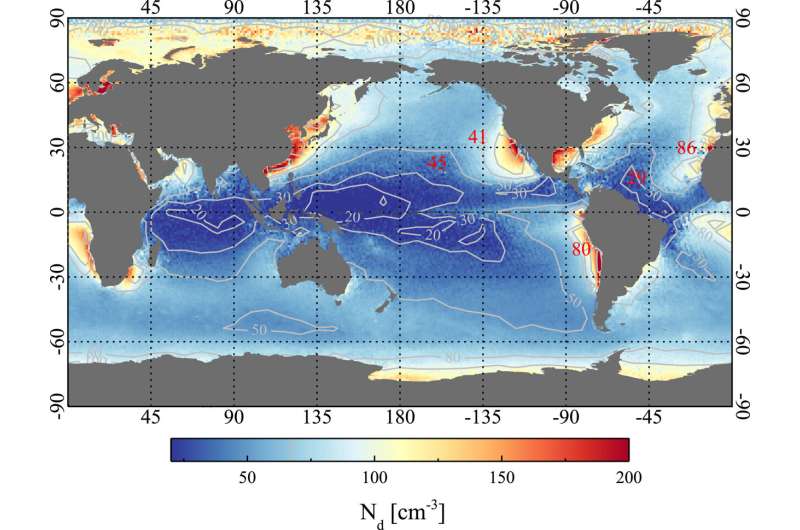This article has been reviewed according to Science X's editorial process and policies. Editors have highlighted the following attributes while ensuring the content's credibility:
fact-checked
peer-reviewed publication
proofread
New climate study shows cloud cover is easier to affect than previously thought

A new analysis of cloud measurements from outside the coast of California, combined with global satellite measurements, reveals that even aerosol particles as small as 25–30 nanometers may contribute to cloud formation. Hence, the climate impact of small aerosols may be underestimated.
Clouds are among the least understood entities in the climate system and the largest source of uncertainty in predicting future climate change. To describe clouds, you need to understand weather systems on the scale of up to hundreds of kilometers and microphysics down to the scale of molecules.
The new study sheds new light on what happens at the molecular scale, focusing on cloud condensation nuclei in marine stratus clouds—low-level, horizontally layered clouds. The study, "Supersaturation and Critical Size of Cloud Condensation Nuclei in Marine Stratus Clouds," is published in Geophysical Research Letters.
It is well-known that cloud formation depends on two basic conditions: 1) The atmosphere is supersaturated with water, meaning there is so much water in the air that it can turn liquid, and 2) A seed particle called a cloud condensation nucleus is present, which the water can condense onto.
These seeds must be larger than a critical size for water to condense and form drops, and it is commonly assumed that the critical size is about 60 nanometers or larger.

Scientists from The Technical University of Denmark, the University of Copenhagen, and the Hebrew University of Jerusalem have investigated this critical size of tiny aerosol particles, or proto seeds. It turns out that a size of 25–30 may be sufficient for them to grow into cloud condensation nuclei.
"Since the proto seeds can be much smaller than previously thought, cloud formation is more sensitive to changes in aerosols than previously thought, especially in pristine areas where marine stratus clouds are dominant," says Henrik Svensmark, a Senior Researcher at DTU Space and lead author of the paper.
Due to a higher supersaturation of water inside the clouds, smaller aerosols are activated into cloud droplets. In simple terms, the more water there is, the easier it can condense and the smaller the seed needs to be.
The study's basis was measurements of marine stratus clouds performed in 2014 by Nevada researchers. These measurements reveal a relationship between the amount of cloud drops and the supersaturation of water in the atmosphere. The measurements, combined with global satellite measurements from the MODIS instrument, allowed the scientists to calculate the cloud drop amount, from which a global map of supersaturation can be found.
Here is the surprise—the supersaturation is generally higher than previously assumed. Since supersaturation determines the critical size of the seed, even tiny seeds can serve as cloud condensation nuclei. Instead of aerosols growing to 60 nm or more, a size of 25–30 nm is sufficient.
"It doesn't look like much, but the implications may be big," says Henrik Svensmark.
"About half of all cloud condensation nuclei are formed by tens of thousands of molecules clumping together one by one, forming an aerosol particle. That takes time; the longer it takes, the larger the risk of getting lost.
"Current models show that due to the growth time, most of the small aerosols are lost before they grow to the critical size, and thus, cloud formation is rather insensitive to changes in the production of small aerosols. Our results change this understanding as aerosols must grow much less, which is important for modeling clouds and climate predictions."
More information: Henrik Svensmark et al, Supersaturation and Critical Size of Cloud Condensation Nuclei in Marine Stratus Clouds, Geophysical Research Letters (2024). DOI: 10.1029/2024GL108140
Journal information: Geophysical Research Letters
Provided by Technical University of Denmark)




















